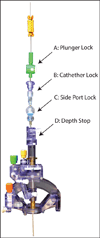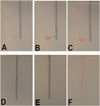Radially branched deployment for more efficient cell transplantation at the scale of the human brain
- PMID: 23343609
- PMCID: PMC3739996
- DOI: 10.1159/000343213
Radially branched deployment for more efficient cell transplantation at the scale of the human brain
Abstract
Background: In preclinical studies, cell transplantation into the brain has shown great promise for the treatment of a wide range of neurological diseases. However, the use of a straight cannula and syringe for cell delivery to the human brain does not approximate cell distribution achieved in animal studies. This technical deficiency may limit the successful clinical translation of cell transplantation.
Objective: To develop a stereotactic device that effectively distributes viable cells to the human brain. Our primary aims were to (1) minimize the number of transcortical penetrations required for transplantation, (2) reduce variability in cell dosing and (3) increase cell survival.
Methods: We developed a modular cannula system capable of radially branched deployment (RBD) of a cell delivery catheter at variable angles from the longitudinal device axis. We also developed an integrated catheter-plunger system, eliminating the need for a separate syringe delivery mechanism. The RBD prototype was evaluated in vitro and in vivo with subcortical injections into the swine brain. Performance was compared to a 20G straight cannula with dual side ports, a device used in current clinical trials.
Results: RBD enabled therapeutic delivery in a precise 'tree-like' pattern branched from a single initial trajectory, thereby facilitating delivery to a volumetrically large target region. RBD could transplant materials in a radial pattern up to 2.0 cm from the initial penetration tract. The novel integrated catheter-plunger system facilitated manual delivery of small and precise volumes of injection (1.36 ± 0.13 µl per cm of plunger travel). Both dilute and highly concentrated neural precursor cell populations tolerated transit through the device with high viability and unaffected developmental potential. While reflux of infusate along the penetration tract was problematic with the use of the 20G cannula, RBD was resistant to this source of cell dose variability in agarose. RBD enabled radial injections to the swine brain when used with a modern clinical stereotactic system.
Conclusions: By increasing the total delivery volume through a single transcortical penetration in agarose models, RBD strategy may provide a new approach for cell transplantation to the human brain. Incorporation of RBD or selected aspects of its design into future clinical trials may increase the likelihood of successful translation of cell-based therapy to the human patient.
Copyright © 2013 S. Karger AG, Basel.
Figures









Similar articles
-
Interventional magnetic resonance imaging-guided cell transplantation into the brain with radially branched deployment.Mol Ther. 2015 Jan;23(1):119-29. doi: 10.1038/mt.2014.155. Epub 2014 Aug 20. Mol Ther. 2015. PMID: 25138755 Free PMC article.
-
Feasibility of Three-Dimensional Placement of Human Therapeutic Stem Cells Using the Intracerebral Microinjection Instrument.Neuromodulation. 2016 Oct;19(7):708-716. doi: 10.1111/ner.12484. Epub 2016 Sep 4. Neuromodulation. 2016. PMID: 27593216
-
Method and Apparatus for the Automated Delivery of Continuous Neural Stem Cell Trails Into the Spinal Cord of Small and Large Animals.Neurosurgery. 2019 Oct 1;85(4):560-573. doi: 10.1093/neuros/nyy379. Neurosurgery. 2019. PMID: 30169668
-
Clinical translation of cell transplantation in the brain.Curr Opin Organ Transplant. 2011 Dec;16(6):632-9. doi: 10.1097/MOT.0b013e32834c2356. Curr Opin Organ Transplant. 2011. PMID: 21926621 Review.
-
Can we rebuild the human brain? The exciting promise and early evidence that stem cells may provide a real clinical cure for stroke in humans.World Neurosurg. 2013 Nov;80(5):e69-72. doi: 10.1016/j.wneu.2012.07.012. Epub 2012 Jul 27. World Neurosurg. 2013. PMID: 22846654 Review. No abstract available.
Cited by
-
Magnetic Resonance Imaging-Guided Delivery of Neural Stem Cells into the Basal Ganglia of Nonhuman Primates Reveals a Pulsatile Mode of Cell Dispersion.Stem Cells Transl Med. 2017 Mar;6(3):877-885. doi: 10.5966/sctm.2016-0269. Epub 2016 Sep 22. Stem Cells Transl Med. 2017. PMID: 28297573 Free PMC article.
-
Nanostructured platforms for the sustained and local delivery of antibiotics in the treatment of osteomyelitis.Crit Rev Ther Drug Carrier Syst. 2015;32(1):1-59. doi: 10.1615/critrevtherdrugcarriersyst.2014010920. Crit Rev Ther Drug Carrier Syst. 2015. PMID: 25746204 Free PMC article. Review.
-
Focused Ultrasound: An Emerging Therapeutic Modality for Neurologic Disease.Neurotherapeutics. 2017 Apr;14(2):393-404. doi: 10.1007/s13311-017-0515-1. Neurotherapeutics. 2017. PMID: 28244011 Free PMC article.
-
Ex vivo biomechanical characterization of syringe-needle ejections for intracerebral cell delivery.Sci Rep. 2018 Jun 15;8(1):9194. doi: 10.1038/s41598-018-27568-x. Sci Rep. 2018. PMID: 29907825 Free PMC article.
-
Treatment of Movement Disorders With Focused Ultrasound.J Cent Nerv Syst Dis. 2017 Jun 6;9:1179573517705670. doi: 10.1177/1179573517705670. eCollection 2017. J Cent Nerv Syst Dis. 2017. PMID: 28615985 Free PMC article. Review.
References
-
- Goldman S. Stem and progenitor cell-based therapy of the human central nervous system. Nat Biotechnol. 2005;23:862–871. - PubMed
-
- Richardson RM, Barbaro NM, Alvarez-Buylla A, Baraban SC. Developing cell transplantation for temporal lobe epilepsy. Neurosurg Focus. 2008;24:E17. - PubMed
-
- Aboody K, Capela A, Niazi N, Stern JH, Temple S. Translating stem cell studies to the clinic for cns repair: Current state of the art and the need for a rosetta stone. Neuron. 2011;70:597–613. - PubMed
-
- Freed CR, Greene PE, Breeze RE, Tsai WY, DuMouchel W, Kao R, Dillon S, Winfield H, Culver S, Trojanowski JQ, Eidelberg D, Fahn S. Transplantation of embryonic dopamine neurons for severe parkinson's disease. New Engl J Med. 2001;344:710–719. - PubMed
Publication types
MeSH terms
Grants and funding
LinkOut - more resources
Full Text Sources
Other Literature Sources

